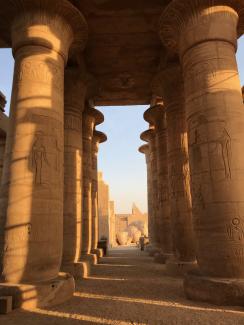
The languages and civilizations of the Near East have been a major part of the University of Chicago's teaching and research commitment since its inception.
William Rainey Harper, the University's founder and first president, was a Hebrew scholar and author of a grammar manual widely used in institutions of higher learning for more than three-quarters of a century. Arabic and Hebrew were taught during the University's first quarter of instruction in 1893. Research done at Chicago has helped to form the very basis of the modern disciplines of Assyriology, Egyptology, and ancient Near Eastern Archaeology.
![Daniel D. Luckenbill examines cuneiform documents. Mr. Luckenbill, a professor of Assyriology at the University of Chicago, was the first editor of the Chicago Assyrian Dictionary. Photo courtesy of University of Chicago Library, Special Collections Research Center [Image Identifier: apf1-04021].](https://humanities-web.s3.us-east-2.amazonaws.com/nelc/prod/styles/max_325x325/s3/2017-11/apf1-04021r.jpg?itok=8kZPh_qS)
The creation of "Islamic Civilization" as a curriculum was effected at Chicago. In all these areas and related subfields a faculty of distinguished scholars now extends this tradition, keeping the University of Chicago at the forefront of worldwide developments in Near Eastern studies. Graduates of the Department have for decades been among the leading international experts in their fields.
![James Henry Breasted, archaeologist and director of the University of Chicago Oriental Institute (1901-1935). Dr. Breasted is at the great temple complex of Karnak in Egypt. Courtesy of University of Chicago Library, Special Collections Research Center, [apf1-02230].](https://humanities-web.s3.us-east-2.amazonaws.com/nelc/prod/styles/max_325x325/s3/2017-11/Breasted.jpg?itok=UwSvSCRW)
An interdisciplinary approach to learning is a characteristic of the Chicago intellectual tradition. The Department of Near Eastern Languages and Civilizations is itself an interdisciplinary group, comprising philologists, linguists, archaeologists, anthropologists, historians, students of religion and law, and others. Students in NELC participate in courses, seminars, and workshops where they, as well as the NELC faculty, interact with their counterparts in anthropology, art history, classics, comparative literature, history, law, linguistics, political science, and religious studies. NELC also has a joint degree program with the Department of Linguistics.
This interdisciplinary and team approach is especially facilitated by the participation of many of the students and faculty in the work of the Institute for the Study of Ancient Cultures and Center for Middle Eastern Studies. The Department also publishes the Journal of Near Eastern Studies, which is one of the leading journals in Ancient Near Eastern and Islamic studies.

